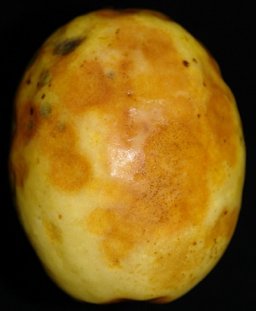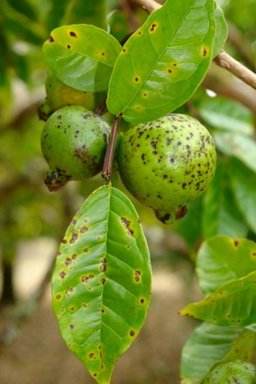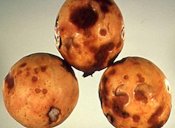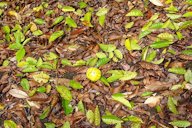| Guava Diseases | |||||||||
|---|---|---|---|---|---|---|---|---|---|
|
Back
to Guava Page  Fig. 1 Anthracnose of guava fruit  Fig. 3 Cephaleuros parasiticus as a parasite of guava leaves and fruit in Hawai'i, causing a leaf and fruit spot disease Back to Guava Page |
Anthracnose Caused by the pathogen Colletotrichum gloeosporioides Anthracnose is the most commonly observed disease that affects both pre- and postharvest management of guava. This disease can cause considerable postharvest losses and can affect young developing flowers and fruit. It has been reported in all guava-growing areas around the world where high rainfall and humidity are present. 1 Symptoms of this disease are observed on mature fruits on the tree. The characteristic symptoms consist of sunken, dark colored, necrotic lesions. Under humid conditions, the necrotic lesions become covered with pinkish spore masses. As the disease progresses, the small sunken lesions coalesce to form large necrotic patches affecting the flesh of the fruit (Fig. 1). 1 Pruning trees to open them to increased light and air movement will decrease the severity of this disease. Including copper in periodic nutritional sprays or applying foliar copper once or twice during the summer usually controls this disease. For more information and control measures, consult your local UF/IFAS Extension agricultural agent. 2
Fig. 2. Anthracnose symptoms on fruit Leaf Spot Caused by Cercospora and Pseudocercospora spp. Pseudocercospora leaf spot is prevalent in warm, humid and rainy guava producing areas of south Florida. Symptoms may occur on leaves, stems and fruit. Small lesions (Fig. 3) appear as irregular to sub-circular, dark smokey brown on the upper leaf surface, with a darker brown, diffuse border. Under high humidity, sporulation of the causal fungus may be seen in lesion centers as greenish-gray, felty tufts of mycelium. Individual lesions may coalesce to form large areas of necrotic tissue. The fungi can infect fruit and cause lesions and fruit cracking which may lead to secondary infections of other opportunistic fungi and bacteria. The source of inoculum most likely originates from infected leaves. The pathogens are capable of directly penetrating host tissues. Once infected, the fungus reproduces abundantly from the lower leaf surfaces. 1 Pruning trees to open them to increased light and air movement will decrease the severity of this disease. Including copper in periodic nutritional sprays or applying foliar copper once or twice during the summer usually controls this disease. For more information and control recommendations please contact your local local UF/IFAS Extension agent. 2 Algal Leaf Spot Caused by the pathogen Cephaleuros virescens Symptoms of leaf infestation are reddish to purplish-brown circular spots. Young fruit and stems are also attacked. Severe red alga infestation may result in leaf and fruit drop and loss of tree vigor. Pruning trees to open them to increased light and air movement will decrease the severity of this disease. Including copper in periodic nutritional sprays or applying foliar copper once or twice during the summer usually controls this disease. For more information and control measures, consult your local UF/IFAS Extension agricultural agent. 2
Fig. 4. Cephaleuros parasiticus as a parasite of guava leaves and fruit in Hawai'i, causing a leaf and fruit spot disease Fig. 5,6. Defoliation and fruit drop due to algal leaf spot Further Reading Cephaleuros Species, the Plant-Parasitic Green Algae, University of Hawai'i CTAHR pdf Nematodes Guava tree roots may be attacked by several types of nematodes (Rotylenchulus reniformis, Radopholus similis, Hemicriconemoides mangiferae, and Meloidogyne incognita, M. arenaria, M. javanica, and M. hapla). Nematodes are microscopic roundworms. Symptoms of nematode attack include loss of tree vigor (stunting), leaf wilting, leaf yellowing, leaf nutrient deficiency symptoms, stem dieback and tree death. Planting of guava trees in known areas with severe nematode problems should be avoided. Mulching and attention to fertilizer and watering may decrease the effects of nematode infestation. 2 Further Reading Reniform Nematode, Rotylenchulus reniformis Linford and Oliveira, University of Florida pdf Burrowing Nematode, Radopholus similis (Cobb, 1893) Thorne, 1949, University of Florida pdf |
||||||||
| Bibliography 1 Merida, Michael, and Aaron J. Palmateer. "2013 Florida Plant Disease Management Guide: Guava (Psidium guajava)." Plant Pathology Dept., UF/IFAS Extension, PP-232, Pub. date June 2006, Revised Apr. 2014, Reviewed Dec. 2017, Archived, AskIFAS, edis.ifas.ufl.edu/pg133. Accessed 10 Dec. 2014, 10 Mar. 2020. 2 Crane, Jonathan H., and Carlos F. Balerdi. "Guava growing in the Florida Home Landscape." Horticultural Sciences Dept., UF/IFAS Extension, Original pub. date Oct. 1979, Revised Jan. 1998, Oct. 2005, and Nov. 2016, Reviewed Dec.2019, AkIFAS, edis.ifas.ufl.edu/mg045. Accessed 29 June 2017, 9 Mar. 2020. Photographs Fig. 1 Nelson, Scot. "Anthracnose of guava fruit." Flickr, 2008, (CC BY 2.0), flickr.com. Accessed 31 Jan. 2017. Fig. 2 "Symptoms of anthracnose on fruit." University of Florida, AskIFAS, edis.ifas.ufl.edu. Accessed 10 Dec. 2014. Fig. 3 Nelson, Scot. "Cephaleuros parasiticus as a parasite of guava leaves and fruit in Hawaii, causing a leaf and fruit spot disease." University of Hawai'i at Mānoa, 2008, Flickr, (CC BY-NC-SA 2.0), flickr.com. Accessed 3 Feb. 2017. Fig. 4 Nelson, Scot. "Algal leaf spot of guava (Psidium guajava. Pathogen: Cephaleuros virescens, Hilo, Hawai'i." University of Hawai'i at Mānoa, 2008, Flickr, (CC BY-NC-SA 2.0), flickr.com. Accessed 3 Feb. 2017. Fig. 5,6 Nelson, Scot. "Guava: Defoliation and fruit drop due to algal leaf spot." University of Hawai'i at Mānoa, 2008, Flickr, (CC BY-NC-SA 2.0), flickr.com. Accessed 3 Feb. 2017. Published 10 Dec. 2014 LR. Last update 6 Feb. 2023 LR |
|||||||||




